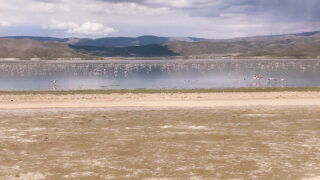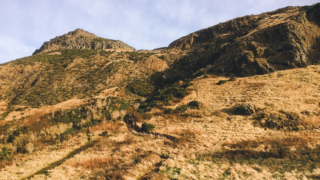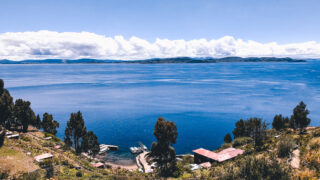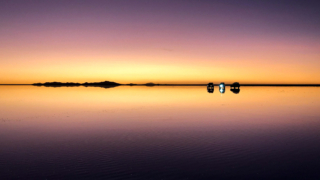Is the Sahara Desert on your life adventure bucket-list? Then this article on camel trekking to a Sahara Desert Camp is one you must read. Experiencing the Sahara Desert in all its orange glory was an unforgettable experience. The three-day desert exploration takes you along the winding roads of the Atlas Mountain, through yellow canyons, and past Berber villages.
Continuing on camelback crossing dunes to a desert camp where you will dance the night away under the star riddled sky. The morning holds a camel ride in the dark to watch the sunrise before returning to Marrakech. Technically the Erg Chebbi dunes are part of the pre-Saharan Steppes, but the experience is unforgettable, nonetheless. You might even spot a scarab beetle.
Trying to figure out what to expect, what to pack, how much it costs, and how to make this Sahara Desert adventure even more exciting with sandboarding or quad biking? Read on to find out why camel trekking to a Sahara Desert Camp is one of the best activities to do when in Marrakech.
Sidenote to anyone who ethically disagrees with camel rides. Your alternative Sahara desert trip would be a day-tour or multi-day trekking. Although, I must say that I did not see the camels being mistreated. This does not mean that it doesn’t happen. When we returned to Merzouga they were freed to wander without ties or fencing.

Post Contents
WHAT TO EXPECT FROM A CAMEL TREKKING TO A SAHARA DESERT CAMP
Day 1. The High Atlas Mountain And Berber Villages.
We rose bright and early for our 7 am collection near our hostel, Equity Point Hostel. The minibus took us out of Marrakesh along a scenic route through the Atlas Mountains with Arabic techno blaring in the background. The roads are curvy. I advise taking motion sickness tablets if you tend to carsickness like me.

The first stop of many was at a High Atlas Mountains viewpoint to take in the dramatic scenery. This is where I took one of my all-time favourite shots of an old man. To this day I have no idea what he was selling. Drop me a comment and tell me what you think it is.
Our next stop was at the UNESCO world heritage site Kasbah Aït Benhaddou. The Moroccan Earthen clay architecture was the first of its kind I had ever observed. The clay buildings are placed in the middle of desert nature with the occasional green crop and palm tree fighting their way through the dry, rocky soil.
To reach the ighrem we had to cross a red river coloured by minerals before making our way up the hill. At the Berber village we were greeted by prayers blaring over the ighrem. The winding alleyways of Aït Benhaddou lead us to a shop where we stopped to enjoy mint tea served in a silver teapot.

We had some time to wander the alleyways, passing clay houses. The colouration of the surrounding hills is incredibly beautiful. The melted red, yellow, and brown create a surreal stripe effect.

The journey continued onto Ouarzazate where we enjoyed lunch at a café. From there we continued to our final destination, Dades Valley. The night was spent at a guesthouse with a pool, bar, and private ensuite rooms. Don’t be misled the rooms are very basic.
Day 2. The Todgha Gorge And Camping Under The Star Riddled Sky In The Sahara Desert.
After breakfast, our journey continued through the dramatic desert landscapes of Dades Valley to Tinghir. We explored the oasis for a while before stopping at a carpentry to learn about how the colourful masterpieces are hand weaved and dyed. In Tinghir we were also able to purchase indigo-dyed scarves to make turbans later in the afternoon.
This is where I lost the group in the maze-like alleyways. A guide from another group was asking me a question and before I knew it, I could not see where my group went. After several phone calls between guides, I was reunited with my group. What can I say? I tend to get distracted.
Thereafter we continued onto Todgha Gorge, a stunning limestone river canyon popular for rock-climbing. The sunlight reflection on the yellow rock formations is incredibly astounding. Unfortunately, our time to walk deeper into the canyon along the riverbed and enjoy the beauty of this place was limited.
The lunch place overlooked a river and canopies. The food in contrast was mediocre and overpriced. From there we continued our journey to Merzouga near the Algerian border where we arrived around 5 pm and where greeted by camels. Before mounting the gentle giants, we learned how to make turbans out of scarves.
This is an opportunity to leave behind anything not required for the overnight stay. Not only will this make your 2 hours on camelback more pleasant but also make the camels lives easier.

Camel Trekking To A Sahara Desert Camp.
Saddling a camel was surprisingly frightening. The animals are taller than I realised. Camels rise with their hindlegs first, leaving you clinching onto the saddle to prevent face planting into the sand. Once all set, we continued into the ergs of Erg Chebbi to our Berber desert camp. Throughout the ride over dunes we were left in amazement of the untouched, red beauty surrounding us.
Camels love a stroke and scratch between the ears. However, bear in mind that if you pet the camel behind you it will try to get your attention for the rest of the journey.

Before reaching the camp, we stopped to absorb the unimaginable reach of the orange sea of dunes formed by wind-blown sand, creating a dramatic desert scenery. Another group had sacks to slide down the dunes.
We dreadfully climbed back onto the camel’s backs before the sun set completely. Full disclaimer, your bum will be aching. This is when a camel refused to carry a tourist leaving him with no choice but to walk the short stretch to the camp.
The whole overnight camping experience felt like a movie scene. We were surrounded by pitch-black darkness I had never experienced prior. Covered by a blanket of bright sparkling stars. We had dinner surrounded by bivouacs (tents), bonfires, and floor cushions. To our surprise, the tangerine was the most delicious meal I had throughout my Morocco trip.
The night ended with a Berber music and drum performance, and dancing around the bonfire. We laughed and hit the drums until our bellies ached. The night ended with one of the most memorable experiences of all my travels. Brushing my teeth in the pitch black under the starlit sky without a sink or running water, making use of the sand to cover your tracks.
The Facilities.
The toilets are a hole in the ground in a bivouac with curtains as doors. Although, it looked surprisingly nice. The smell is something that stays with you. The sleeping tent on the other hand was surprisingly comfortable with pillows, blankets, and mattresses. Be prepared to sleep next to a stranger unless your booking agreement was otherwise. If this doesn’t sound like you then look into the Merzouga luxury camp.
Day 3. Camel Ride In The Dark.

The final day began with an early 6 am wake up call. We felt somewhat lost when asked to mount our camels in the pitch black without any guidance to which animal resting in the sand was ours. To my surprise these even-toed ungulates with enviable eyelashes recognise their riders. I was greeted by my camel with a rather strange noise, head nod, and what appeared to be excited to see me.
Sleepy, we embarked on our ride through the darkness to one of Morocco’s several ergs in the Erg Chebbi dunes rising to 150 metres. How my friend fell asleep on the camel’s back is beyond me. Trusting the animals to find their footing in the pitch black was frightening. Every trip will make you think that you are about to fall down a dune hill.
Don’t be surprised if you suddenly stop for the guide to pull out a carpet, kneeling for early prayers.

After heavy strides to the top of the sand dune, we marvelled at the view of the orange dunes stretching endlessly with the bright orange and yellow sunrise filling us with new adrenaline.
Once we returned to Merzouga we had breakfast before embarking on our 9-hour ride through the Draa Valley before returning to Marrakech around 19.30 h. On the way back my friend’s seatbelt decided to keep her trapped. Literally! She had to climb out from under the belt to be free.
ALTERNATIVE MOROCCO SAHARA DESERT ACTIVITIES
The cheapest option would be to travel to Merzouga and book the explorations from there. Although, these activities can be booked at any tourist destination.
Desert Trekking.
The three-day dune trekking isn’t an adventure for the faint-hearted. You will be sleeping in different camps and hike 4 – 5 hours a day. It is advisable to book this tour during winter when the daytime temperatures are lowest.
Sandboarding.
There are two-day tours from Merzouga including a camel ride to the desert camps. Please note that sandboarding is often at an additional cost to the € 30 for the tour.
Quad Biking.
Quad bikes can only be rented by the hour in Merzouga and not be driven to the desert camps. I could not find a tour that included a night in the Sahara and quad biking (2018), let me know if anything has changed in the comments. The cost is around € 40/ hour.
4×4 Jeep Explorations.

Again, this one-day desert excursion does not include an overnight stay in a desert camp. This is your best option if you are opposed to camel trekking but want to make the most of your desert trip. On this tour you will be visiting Berber villages, Hassi Labied Oasis, fossil mines, nomad families, and experience the orange dunes of the Sahara.
Outside of summer, travellers will also be taken to Dayet Srji. The salt lake is dry in summer. When filled with water it attracts an array of desert birds such as the Egyptian nightjars, and sometimes even flamingos. Cost around € 30.

RECOMMENDATIONS
To add extra excitement to your experience I suggest finding a tour operator that allows you to rent a sandboard for a fee as part of the tour. I prioritised budget over add ons, but it looked fun.
Stating the obvious but you get more out of three-day tours opposed to two-day Sahara Desert tours. Although you will not miss out on the true Moroccan Sahara adventures. The two-day tour solely cuts down on the Berber villages experience.
Best Time To Visit.
The best time to visit the Sahara Desert is May and October when temperatures are mildest. I visited in October and it was never unbearably hot or cold.
The nights are cold during December to January. Various January and May see the most frequent sandstorms. The worst time to visit is between June to September when temperatures reach up to 45 C.

THE COST OF CAMEL TREKKING TO A SAHARA DESERT CAMP
We booked our tour through our hostel Equity Point in Marrakesh. The three-day desert trip cost DH 800 (2018) compared to DH 500 for two-day tours. The price includes the minibus transport, breakfast, dinners, a night in a guesthouse, and the Berber desert camp. The cost does not include lunch, drinks, and any souvenirs you might want to buy along the way.

WHAT TO PACK FOR CAMEL TREKKING TO A SAHARA DESERT CAMP
The days contrasting, daytime is hot, and the nights are chilly. Bring high factor sun cream and layering pieces to keep warm at night. But most importantly make sure you have a cap, as well as a scarf or bandana to protect your face from the sun and wind blowing sand in your face. Make sure to bring twice as much water as you normally drink and motions sickness tablets

WHERE TO NEXT
The starting point of a trip to the Sahara commonly is Marrakesh or Fes. However, there are also four-day tours from Casablanca via Fes. To make the most of your time you can start and finish in different cities.
Did I do a good job of sharing my love for this unforgettable experience of camel trekking to a Sahara Desert camp?
Now go ahead and explore! Try not to lose your towel.






























